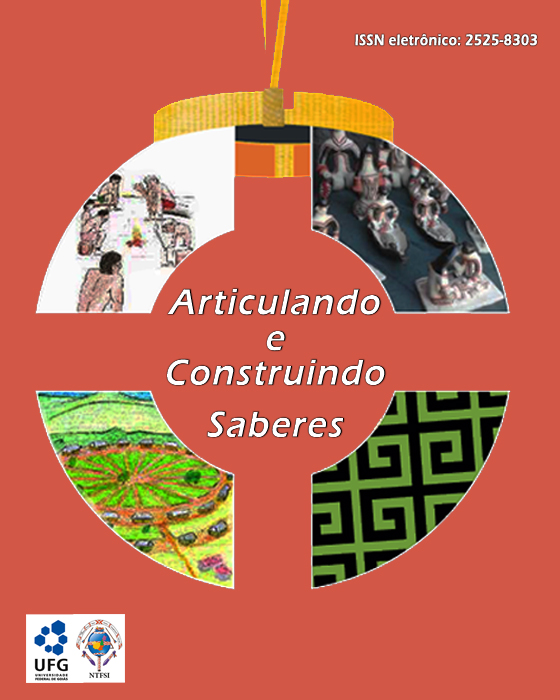Phonetic and phonological observations on vowels in the Wakalitesu language
DOI:
https://doi.org/10.5216/racs.v5i.63598Keywords:
Phonetics, Phonology, Wakalitesu Language, NambikwaraAbstract
In this paper, we present preliminary observations on phonetic and phonological aspects of vowels in the Wakalitesu language, as result of linguistic studies and teacher training activities, carried out in the Três Jacus community, located in the Indigenous Land Tirecatinga, in the municipality of Sapezal-MT. The Wakalitesu belong to the Southern branch of the Nambikwaran family. According to Price (1983), the groups of the Nambikwaran family, despite sharing cultural traits, present significant linguistic differences. Rodrigues (2002) and Telles (2014) state that there are criteria of intelligibility between languages, among groups of the Nambikwara family. Thus, in addition to phonetic and phonological observations, we made some comparisons with language studies of the Nambikwaran family, especially those of Kroeker (2003) and Souza Netto (2018), highlighting similarities and differences between them. The proposed observations were based on the theoretical and methodological perspectives of Pike (1976), Kindell (1981), Cagliari (2002), Callou and Leite (2003) and Kibrik (1977).
Downloads
References
BRAGGIO, Silvia Bigonjal. A Instauração da Escrita entre os Xerente: conflitos e resistências. Revista do Museu Antropológico. Goiânia, v.3/4 nº 1, p. 19-42, 1999/2000.
CAGLIARI, Luiz Carlos. Análise fonológica: introdução à teoria e à prática, com especial destaque para o modelo fonêmico. Campinas, SP.: Mercado de Letras, 2002. – (Coleção Ideias sobre Linguagem).
CALLOU, Dinah & LEITE, Yonne. Iniciação à fonética e à fonologia. Rio de Janeiro: Jorge Zahar Ed., 2003.
COSTA, Anna Maria R. F. M. Senhores da Memória: uma história do Nambiquara do cerrado. Cuiabá: UNICEN Publicações, 2002.
EBERHARD, David. Mamaindê grammar: a northern Nambikwara language and its cultural context , 2009. Disponível em: http://www.sil.org/resources/publications/entry/41276. Acesso em: 20 jun. 2018.
IPA - The sounds of the IPA. London: Phonetics & Linguistics U.C.L, 1995 CD-ROM - Produced by the Listening Centre, Department of Phonetics and Linguistics - University College London - Wolfson House 4 Stephenson Way, London. NW 1 2 HE.
KIBRIK, A. E. The Methodology of field investigations in Linguistics. Paris: Mouton, 1977.
KINDELL, Glória Elaine. Guia de Análise Fonológica. Brasília: Summer Institute of Linguistics, 1981.
KROEKER, Menno. Gramática Descritiva da Língua Nambikuara. Cuiabá: Sociedade Internacional de Linguística, 2003.
OLIVEIRA, Alex Feitosa de. Línguas Conviventes: aspectos sociolinguísticos na aldeia Três Jacus – comunidade Wakalitesu/Nambikwara. Dissertação (Mestrado em Estudos de Linguagem) Cuiabá: Universidade Federal de Mato Grosso, 2018.
PIKE, Kenneth L. Phonemics: a technique for reducing languages to writing. Ann Arbor: The University of Michigan Press, 1976.
PIMENTEL DA SILVA, Maria do Socorro. A linguagem na construção social do conhecimento no contexto escolar indígena. In: Revista do Museu Antropológico. Goiânia, v. 5/6, n.1, p. 141-156, 2001/2002.
PRICE, David. Pareci, Cabixi, Nambiquara: a Case Study in the Western Classification of Native Peoples. Paris: Journal de la Société des Américanistes, v. 69, p.129-148, 1983.
RODRIGUES, A. D. Línguas Brasileiras: para o conhecimento das línguas indígenas. São Paulo: Edições Loyola, 2002.
SOUZA NETTO, Luiz Antônio de. Fonologia do Grupo Nambikwára do Campo (Nambikwára do Sul). Dissertação (Mestrado em Letras). Recife: Universidade Federal de Pernambuco, 2018.
TELLES, Stela. Aspectos Tipológicos da Fonologia Nambikwára: uma família isolada ao sul da Amazônia brasileira. In: MAGALHÃES, José S. de (org). Fonologia (Linguística in Focus), v. 10. Uberlândia: EDUFU, 2014, p. 51-72.
VANDRESEN, Paulino. Preservação das Línguas e Culturas Indígenas. Boletim da ABRALIN. Curitiba, v. 7, p. 55-61, 1986.
Downloads
Published
How to Cite
Issue
Section
License
Authors authorize Articulando e Construindo Saberes to publish an article, if accepted, signing their contribution as original and not submitted to another publisher for publication. If accepted and published, Articulando e Construindo Saberes articles have a Creative Comons CC-BY license.




